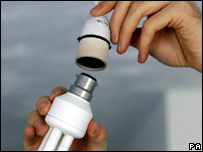Herbalist Dr MziziMkavu
JF-Expert Member
- Feb 3, 2009
- 42,295
- 33,079


Low-energy bulbs contain a small amount of mercury

The Environment Agency has called for more information to be made available on the health and environmental risks posed by low-energy light bulbs. It says because the bulbs contain small amounts of mercury, more information about safe recycling is needed.
It also wants health warnings printed on packaging and information on how to clear up smashed bulbs in the home.
But a toxicologist has played down the risks, saying several bulbs would have to be smashed at once to pose a danger.
Toxic substance
Environmental scientist Dr David Spurgeon said: "Because these light bulbs contain small amounts of mercury they could cause a problem if they are disposed of in a normal waste-bin.
"It is possible that the mercury they contain could be released either into the air or from land-fill when they are released into the wider environment.
"That's a concern, because mercury is a well known toxic substance."



Dr David Ray, toxicologist
Official advice from the Department of the Environment states that if a low-energy bulb is smashed, the room needs to be vacated for at least 15 minutes.
A vacuum cleaner should not be used to clear up the debris, and care should be taken not to inhale the dust.
Instead, rubber gloves should be used, and the broken bulb put into a sealed plastic bag - which should be taken to the local council for disposal.
Unbroken used bulbs can be taken back to the retailer if the owner is a member of the Distributor Takeback Scheme.
Otherwise, many local waste disposal sites now have the facilities to safely collect and dispose of old bulbs.
However, this advice is not printed on the packaging that low-energy bulbs are sold in.
Toxicologist Dr David Ray, from the University of Nottingham, said about 6-8mg of mercury was present in a typical low-energy bulb, which he described as a "pretty small amount".
"Mercury accumulates in the body - especially the brain," he said. "The biggest danger is repeated exposure - a one off exposure is not as potentially dangerous compared to working in a light bulb factory.
"If you smash one bulb then that is not too much of a hazard. However, if you broke five bulbs in a small unventilated room then you might be in short term danger."
Information campaign
Adrian Harding of the Environment Agency said: "More information does need to be made available by retailers, local authorities and the government to alert people to the best way of dealing with these products when they become waste."
Louise Molloy from the environmental group Greenpeace said that a public information campaign was needed in order to advise people how to dispose of low-energy bulbs safely.
But she added: "Rather than being worried about the mercury these light bulbs contain, the general public should be reassured that using them will actually reduce the amount of mercury overall in our atmosphere."
The lighting industry and the government say the risk of mercury pollution posed by low-energy bulbs is minimal.
Kevin Verdun of the Lighting Association said: "Fluorescent strips, like the ones used in garages and kitchens, also contain mercury and have been used for many years without poisoning anyone."
But he said that warnings on how to safely dispose of smashed bulbs "might" be put on packaging in future, if the government and the public demanded it.
This month shops in the UK will begin the process of phasing out traditional tungsten bulbs as part of a government plan to completely replace them by 2011.
Ministers hope that using the more environmentally-friendly bulbs will save at least save 5m tonnes-worth of carbon dioxide emissions every year.
Source: BBC NEWS | UK | Low-energy bulb disposal warning